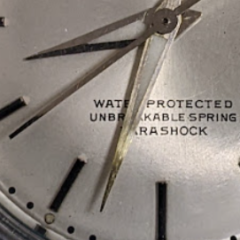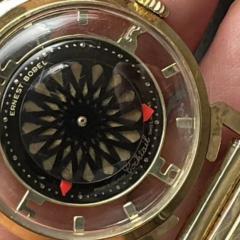Selecting the right crystal for project #2
-
Similar Content
-
Recently Browsing
- No registered users viewing this page.
-
Topics
-
Posts
-
By rossjackson01 · Posted
So please we have that comment. Eccentric59. Great work. -
Thanks @nevenbekriev. I did some further reading and I think I kinda understand it now. Basically, if you were to fully fill the entire barrel with a super-long mainspring, you can't actually wind it anymore. Hence zero power reserve. Likewise the other extreme (mainspring too short to be wound around the arbor). This explains in very basic turns why there is a sweet spot in the middle of the curve you drew. Importantly, this is relative to the barrel diameter (and arbor diameter). In other words, if you have a larger barrel you should have a longer mainspring and hence also longer power reserve. So Longines' statement isn't entirely wrong (longer mainspring = more power reserve). BUT you can only make the mainspring longer if you also increase the barrel diameter. Thanks again for making me think about this a bit more and learning something. That's why I love this forum! However 😉, there is still some truth to what I said (I think! Please correct me if I'm wrong!): according to my reading, the key parameter is the share of the space between barrel arbor and barrel wall. Half of which should be occupied by the mainspring (based on Theory of Horology by WOSTEP, quote in depth here: https://www.vintagewatchstraps.com/mainsprings.php). The space occupied by the mainspring in the barrel is a simple function of mainspring length AND thickness. This implies that increasing length, but keeping the same thickness, will lead to occupying too much of the barrel space and hence reducing power reserve. This is what @nevenbekriev 's drawing correctly shows. However, if you increase length AND decrease thickness in the correct ratio, you can maintain the correct mainspring proportion vis-a-vis the barrel (i.e. occupying half of the space between arbor and barrel wall). This would indeed lead to an increase of the number of barrel revolutions (when unwinding) and hence a potential increase in power reserve. However, you loose torque. And a loss of torque will also lead to the watch stopping earlier (when torque can't overcome the friction in the gear train). Thus, these two opposing effects may cancel each other out. Which again makes this statement probably true: FINALLY, we still want to help @Zendoc with his very concrete decision: GR4485 (same thickness but shorter than original) or GR4477 (slightly thinner and a bit longer than original). I would still advocate (considering modern lubricants and potentially stronger metal alloys -- and consequently the risk of knocking at full wind) to choose the latter.
-
By Neverenoughwatches · Posted
Thats a good record Michael, i always do a quick scan through sone of the feedback comments to make sure there are a good few of them relating to sales and not just purchaese. Feedback can be faked but you can usually spot the dodgy sellers. I have heard that before about lots of orphan watches in Australia 🤔. How far overseas are you going with buying ? There are lots of good sellers here in the UK, shipping is a bit prohibitive though. Main reason for seeing non cased vintages watches would have been the scrapage of the precious metal cases. I think we decide early on what we want from the hobby, whether that is to repair for the fun, enjoyment and sheer challenge of learning something obscure. To collect watches and have that ability to maintain them, to gain financially from re-sale or a mixture of those. Its also important to remain aware of how deep the rabbit hole goes and how much money it takes to continue the descent. -
By nevenbekriev · Posted
No, trus me, this is totally wrong. Firs of all, there is theoretical lenght for a fixed other parameters (spring thickness, barrel internal diameter and arbour diameter), which will give maximal power reserve. This is written in all text books, but I have never seen in the text books mathematical expression (formula) of the relation lenght/power reserve. I am to lazy to generate that expression now, but will draw for You the graphical representation of it. As You can see, there is a maximum in the middle, but the slope near the maximum is really small, so even change of the lenght of let say +/- 30% doesn't lead to significant change of the power reserve. More to that, sometimes movement designers put much longer springs in the barrels than the theoretical lenght for maximm reserve. This is ecpecially in high grade movements. You will sometimes see that the spring covers not the half, but actually 2/3 of the barrel free space. The designers compensate this loss of power reserve by usage of bigger barrels. This way they achieve much smaller difference in full wind / end of power reserve torque. In such case, reducing the spring lenght leads to increasing of power reserve...
-










.thumb.jpg.cb17a66989f1e796fd4217db2e9ca9df.jpg)

Recommended Posts
Join the conversation
You can post now and register later. If you have an account, sign in now to post with your account.
Note: Your post will require moderator approval before it will be visible.